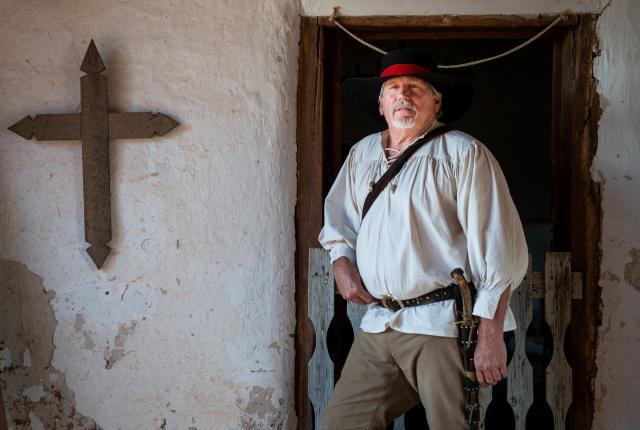“WE COULDN'T DO IT without them,” says Laura Gonzales, Las Golondrinas’s director of education and volunteer services. She’s talking about the approximately 130 volunteers who bring the museum to life by wearing period garb, interpreting their surroundings, and demonstrating blacksmithing, weaving, bread-making, and many other skills employed by New Mexicans in the frontier era.
Becoming a volunteer at Las Golondrinas requires attending a boot camp to start learning hundreds of years of history. “It’s a pretty heavy curriculum for about a month,” Gonzales says. But most of the training is hands-on.
“You just have to get out here, get in the costume,” Gonzales says. “I set up an apprentice program where they just spend time with the veteran volunteers, and they move around the property and they kind of find their niche.”
The volunteers, Gonzales says, portray people from all walks of life rather than specific historical figures. “We want people to know the stories of the everyday men, women, and children who made up life in New Mexico,” she says. “They deserve just as much attention as the famous ones that made it into the pages of history.”
When volunteers express interest in acquiring new skills, Gonzales says, “That’s our exchange. You give us your time, I’ll teach you some skills in whatever your interest is in.”
For their part, the volunteers express a love of history and a sense of camaraderie at the ranch.
Jolanta Tuzel, an horno bread baker, estimates she’s been volunteering for 17 years. She says the most surprising fact she’s learned is that hornos—the beehive-shaped adobe ovens—originated in North Africa. “I assumed it was Native American, because they’re very popular on the pueblos,” she says. “So that was my big surprise. And many people make that assumption.”
Linda Hixon, a 23-year volunteer, wrangled goats during the Spring & Fiber Festival and has been assigned to all the stations—except for the mills. “I am not conversant in mills,” Hixon says. Bottom line? “I love history,” she says, noting that she probably owns copies of half the books available in Las Golondrinas’s gift shop. “Every time I learn something new, I try to incorporate it into my spiel.”
Doug Ash, a two-year volunteer, wore a soldier’s uniform at a recent festival. “I like to dress up and act and meet people,” he says. “I love history, and I like to explain things to people in an entertaining manner.”
Patricia Tucker, 13-year volunteer, 2011 Volunteer of the Year, and weaving coordinator, says of the work: “I love it. This is one of my favorite places in the world. People say, ‘Have a good day,’ and I say, ‘Any day at the ranch is a good day.’ ”
Lynne Cantwell moved to New Mexico during the pandemic. Her first day of volunteering took place June 4 at the Spring & Fiber Festival, where she showed visitors how to card the sheep wool. Cantwell had been a knitter for years and had also learned to weave. When she learned of Las Golondrinas’s weaving program, “This seemed like a good way to expand my skills. I don’t know how to use the Navajo spindle; I would really like to learn how to do that at some point.”
Pedro Martinez, a 10-year volunteer and 2018 Volunteer of the Year who portrays a soldier and blacksmith, says he likes both New Mexico history and occasionally researching his own family’s history. Volunteering, he says, gives him the opportunity “to correct a lot of stuff that has been taught in schools and stuff.” Plus: “You meet a lot of people, different people. It’s interesting.”




